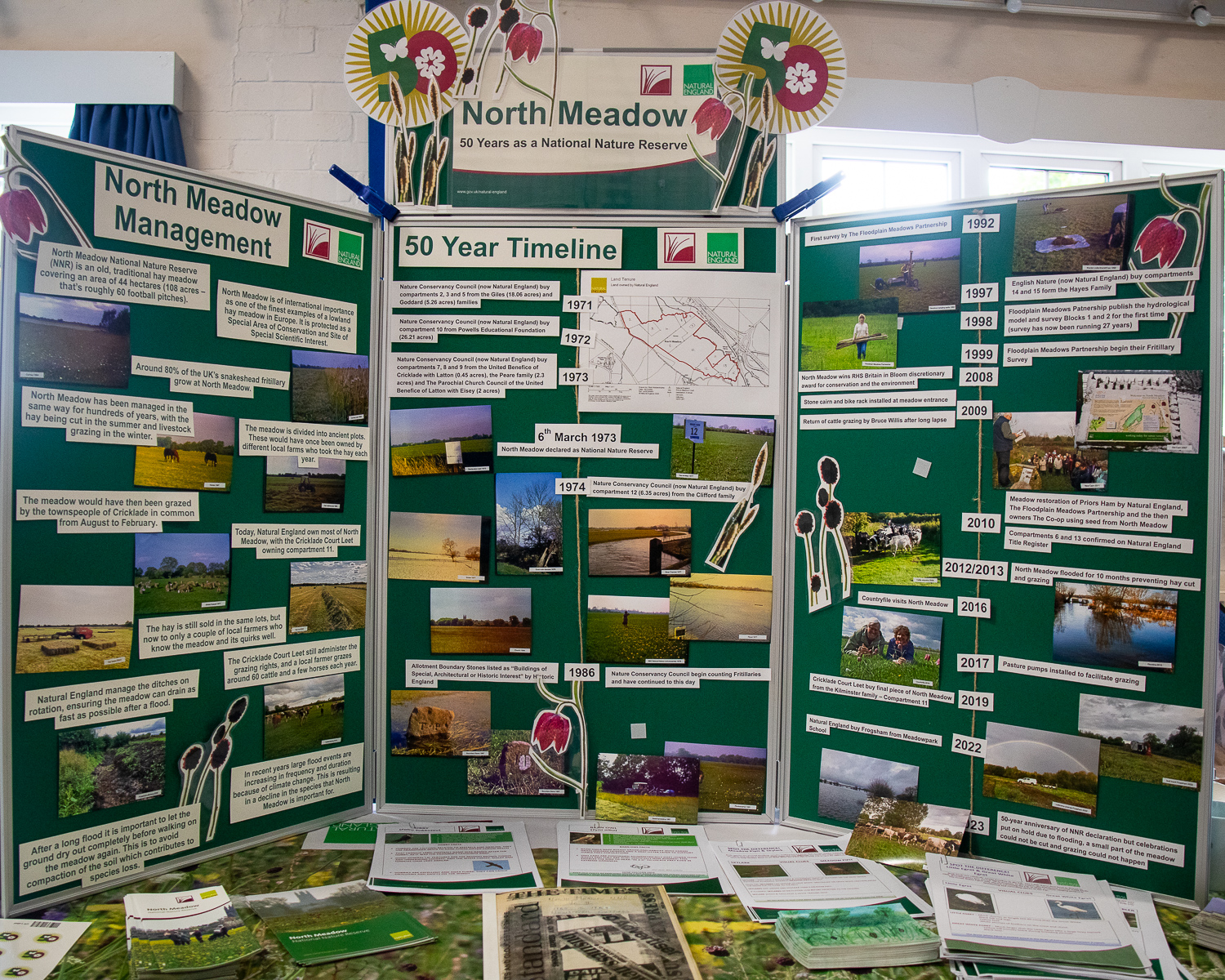We spent Saturday 1st June at Cricklade Town Hall, along with Cricklade Court Leet and Natural England. This event was the culmination of a 2-week epic bioblitz, with multiple specialists and volunteers foraging around in North Meadow to try and produce a more comprehensive assessment of what actually lives and uses the meadow and the supporting habitats. This event was the final part of Cricklade Court Leet’s Heritage Lottery Project but also offered an opportunity to celebrate 51 years of North meadow as a National Nature Reserve and for us to share our 28 years of research at North Meadow, making it the most important research site in the UK for floodplain meadows.
 Photos by John Barratt.
Photos by John Barratt.
The event included talks from Andy Rumming (floodplain meadow farmer), Laurance Hill (snake’s-head fritillary researcher) and Andrew Commins (Natural England reserves Manager and bird specialist)
The results, many of which are still being processed, were fascinating and the day was ‘abuzz’ with facts about the meadow. Unfortunately, due to the exceptionally wet weather this winter and spring, North Meadow itself was still closed, so people were not able to visit the actual site.
Andy told us about the importance of floodplain meadow hay for his cattle, how healthy it is and how the animals actively seek it out, especially when it has lots of bird’s-foot trefoil. He also manned a popular ‘make your own keyring’ stall, using leather made from his own animals and tanned and produced in the UK using only sustainable, vegetable based tanning processes.
 Andy Rumming's stand at the BioBlitz. Photo by John Barratt.
Andy Rumming's stand at the BioBlitz. Photo by John Barratt.
Laurance told us about snake’s-head fritillaries across Europe, some fascinating information about their history and then showed some of his amazing photographs that reveal so many differences even within the same species.
Andrew, who had been surveying the birds at North Meadow as part of the bioblitz, has compiled records for all species he recorded and found previously, and announced that 100 different bird species are using the meadow and the supporting habitats at different times of year, grouped into 21 families. He made us realise that North Meadow is a critically important habitat in its own right because of the diversity of habitats it offers these different bird species. The bioblitz also picked up a booming bittern and curlews looking for nest sites!
Alongside the speakers, the Bioblitz has produced lots of interest amongst invertebrate specialists who were very excited to be given access to such an important site. Records have been collected covering beetles, flies, moths, butterflies and spiders. Marc Taylor was on hand with his microscope, and had pinned 80 (80!) different species of fly collected from North Meadow in the 2 week epic.
 Flies of North Meadow. Photo by John Barratt.
Flies of North Meadow. Photo by John Barratt.
Finally, we had data collected about mammals and the beaver bus was outside. Bats, water voles, and even otters have been recorded. The video of otters captured on the churn was fabulous to see!
North Meadow is an ancient meadow, with an ecosystem to match. This bioblitz has just confirmed this. We already knew how important it was for plants, but we now know it is important in its own right for everything else. However, it is vulnerable. Climate change and associated excessive flooding this year and last will have an effect. And the increase in public interest and access across the site, whilst great, is also a risk to the ecosystem.
The Court Leet and Natural England are continuing the work to collect species records, so if you missed out the first time, there may still be a chance to get involved. Records can still be submitted here https://irecord.org.uk/join/north-meadow-bioblitz.
We have already carried out our annual survey this June, and we are also exploring the link between compaction, species diversity and soil carbon storage this year. So lots more going on!
North Meadow is currently still closed to the public, however it is being reviewed on 13th June and may be opened after that.
 51 years of North Meadow as a National Nature Reserve. Photo by John Barratt.
51 years of North Meadow as a National Nature Reserve. Photo by John Barratt.
